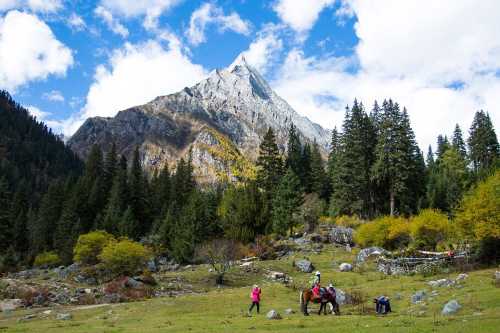Popular Trip Moments
First Stop for Graduation Trip: Western Sichuan | Four Darunee Accommodation Worth Staying | 8 Hours from Chengdu! Step into the Wild Aesthetic World of Lixiao Road | Snow Mountain Gallery: The Enchanting Shuangqiao Valley | Sichuan Adventure: Discover Jiuzhaigou, Huanglong, and Mount Siguniang | Four Sisters Mountain in March | ⛰️ 𝑺𝒊𝒈𝒖𝒏𝒊𝒂𝒏𝒈𝒔𝒉𝒂𝒏 - Shuangqiaogou | Chengdu in One Day: Where to Go? | Snow Mountain Pool and Handsome Xiao | Traveling to Xiao Jin for 3 days: Must-visit spots | Encountering Siguniang Mountain: A Romantic Rendezvous with Snow-Capped Peaks | A Spiritual Retreat by Siguniang Mountain | Chengdu 6-day travel plan | Western Sichuan "Instead of longing, just set off" | Two-Day One-Night Travel Guide in Western Sichuan | The journey is as beautiful as the destination | Recommended Homestays in Siguniangshan: I've Booked the Yaomei Peak View Here | N Reasons to Visit Western Sichuan in May-June – If You're Not Tempted, I Lose! | Listen to me! June to August is the must-go season for Western Sichuan, you'll regret missing it | The Most "Costume-Changing" Sacred Mountain in Western Sichuan | How to Take Atmospheric Memorial Photos at the Landmark Known as the "Pinnacle of the Kingdom"? | Just got back from Western Sichuan, to be honest... | Snow Mountains · Alpine Lakes · Meadows | The Most Enchanting Guide to Siguniangshan | Four Girls Mountain · Sky City Cliff Hotel, a Cloud Wonderland | Just pack and go! This Western Sichuan guide is simple and clear! | Stay in the Clouds! The Sky City Cliff Hotel in Siguniang Mountain Takes Your Breath Away! | 🏔️ Four Girls, Shuangqiaogou Trail on a Cloudy Day ☁️ | Heavenly Retreat in Western Sichuan! Siguniang Mountain·Sky City Cliff Hotel, Absolutely Stunning! | Mount Siguniang: Experience the Beauty of China's Alps | Mount Siguniang: The Eastern Alps
Recommended Attractions at Popular Destinations
Bangkok attraction near me | Manila attraction near me | Tokyo attraction near me | Taipei attraction near me | Hong Kong attraction near me | Seoul attraction near me | Kuala Lumpur attraction near me | Los Angeles attraction near me | Shanghai attraction near me | New York attraction near me | Shenzhen attraction near me | Osaka attraction near me | Singapore attraction near me | London attraction near me | Guangzhou attraction near me | San Francisco attraction near me | Beijing attraction near me | Macau attraction near me | Bali attraction near me | Jakarta attraction near me | Paris attraction near me | Ho Chi Minh City attraction near me | Istanbul attraction near me | Phuket attraction near me | Chicago attraction near me | Seattle attraction near me | Toronto attraction near me | Orlando attraction near me | Cebu attraction near me | Chiang Mai attraction near me
Popular Attractions
South Bridge | Stalin Park | Yangtze River Night Cruise (Ferry Trip to Three Gorges) | The Princess House | Pilu Temple | Madame Tussauds Shanghai | China Art Museum | Three Pools Mirroring the Moon | Zhujiajiao Ancient Town | Polynesian Spa | Huangpu River Cruise(Shiliupu Pier) | Oriental Buddha Capital | Shizi Mountain Sceneic Area | Temple of Olympian Zeus | Falaj Al-Qaba'il West Mosque | Kiss Of The Sea | Hon Thom Departure Terminal - Sun World Hon Thom Nature Park | Red Cube of Shenzhen | Queen Mother Pond | Stropnice | Sree Kovattu Bhagavathy Temple | Ekta Park | Gamba di Donna AMP | Selimiye Cami | Gereja Katolik Santo Thomas Rasul | Merthyr Park | Yasaka Park | Saiwaicho Park | Tottori Sakyu Kodomo-no-kuni | Shanghai Romance Park
Popular Restaurants in Xiaojin
暮山映雪·私汤度假别院(四姑娘山双桥沟景区店)·餐厅 | 悦山度假酒店餐厅 | 四姑娘山安兰酒店·餐厅 | SI GU NIANG SHAN CHENG DOU FAN DIAN | 莲花山居致美餐厅 | 四姑娘山阿巴郎·藏式花园餐厅 | 川香人家(江西路店) | 3360咖啡屋 | Eating Taste Sichuan Cuisine Restaurant | 林妹妹火锅店 | 大侠烧烤(中国熊猫大道店) | 双流肥肠粉川菜饭店 | 四姑娘山绒雪藏庄 | Jajong Traditional Clay Pot | 甲几部落藏餐吧 | 八六藏餐(赞拉店) | 云舍·厘 | 四姑娘山山水情缘客栈 | 渝州饭店 | ICED ROCK BAR 冰石酒吧 | 悦来香火锅店 | 四姑娘山在这里客栈·在这里餐馆 | 三生三世十里桃花餐饮部 | 四姑娘山伴山度假酒店(四姑娘山长坪沟景区店)·特色餐厅 | 四姑娘山·天空之城悬崖酒店·悬崖餐厅 | 四姑娘山仰望星空·Vacilando度假庄园(长坪沟景区店)·猎户餐厅 | 暮山映雪·度假别院(四姑娘山长坪沟景区店)·餐厅 | 四姑娘山·天空之城悬崖酒店·云端餐厅 | 面条 | Guangchang Restaurant
Popular Ranked Lists
Top 6 Best Things to Do in Yongzhou | Popular Premium Hotels Near Geraldine | Popular Best Things to Do in Wuzhishan | Top 10 Best Things to Do in Aksu Prefecture | Popular Must-Visit Restaurants in Milan | Top 4 Best Things to Do in Mohe | Popular Luxury Hotels Near Taean-gun | Top 3 Luxury Hotels in Dhaka Division | Top 5 Best Things to Do in Ji'an | Popular Luxury Hotels Near Etretat | Popular Luxury Hotels Near Century City | Popular Luxury Hotels Near Fishers | Top 4 Best Things to Do in Changji Prefecture | Popular Premium Hotels Near Dearborn | Popular Best Things to Do in Ziyuan | Top 3 Luxury Hotels in Dhaka | Popular Best Things to Do in Suifenhe | Popular Local Restaurants in Shanghai | Top 3 Luxury Hotels in Almaty | Popular Luxury Hotels in Kieni East | Popular Best Things to Do in Shaoyang | Popular Luxury Hotels in Fes-Meknes | Popular Must-Visit Restaurants in Dubai | Popular Luxury Hotels in Dhofar | Popular Must-Visit Restaurants in Singapore | Popular Luxury Hotels in Oslo | Popular Must-Visit Restaurants in London | Popular Local Restaurants in Bangkok | Popular Luxury Hotels Near Tonosho | Popular Luxury Hotels in Mirbat
Payment Methods
Our Partners
Copyright © 2025 Trip.com Travel Singapore Pte. Ltd. All rights reserved
Site Operator: Trip.com Travel Singapore Pte. Ltd.
Site Operator: Trip.com Travel Singapore Pte. Ltd.















